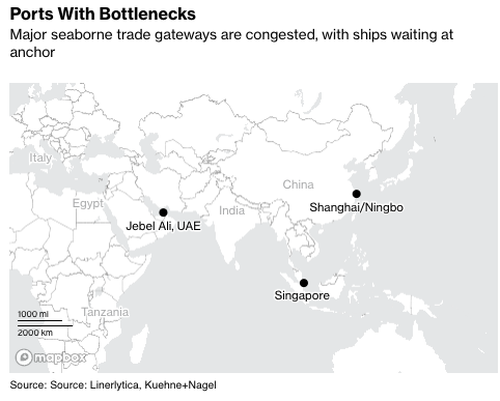For Second Time, Maersk Lifts Guidance As Red Sea Crisis Sends Container Freight Rates Soaring
A.P. Moller-Maersk A/S has raised its full-year guidance for the second time in a month. This upward adjustment comes as strong demand for containerized shipping, along with disruptions in the Red Sea, has led to a surge in the cost of shipping a 40-foot container on major shipping routes.
The Denmark-based shipper, a bellwether for global trade, wrote in a press release Monday, “On the back of continued strong container market demand and the disruption caused by the ongoing crisis in the Red Sea, A.P. Moller – Maersk A/S (Maersk) now also sees signs of further port congestions, especially in Asia and the Middle East, and additional increase in container freight rates.”
Maersk pointed out, “This development is gradually building up and is expected to contribute to a stronger financial performance in the second half of 2024.” Higher container costs allowed for a second upward revision in its annual outlook in a month. The shipper now expects earnings before interest, tax, depreciation, and amortization of $7 billion to $9 billion, up from its earlier estimate of $4 billion to $6 billion.
However, the shipper noted, “Trading conditions remain subject to higher-than-normal volatility given the unpredictability of the Red Sea situation and the lack of clarity of future supply and demand.”
The Red Sea crisis has had a profound impact on containerized shipping, with Bloomberg Intelligence estimating an 80% reduction in container sails through the Suez Canal. This has forced ships to take longer routes, such as sailing around the Cape of Good Hope, adding at least a week to their total travel time. As a result, global fleet capacity has been reduced, leading to a significant boost in containerized freight rates.
We covered this dynamic in a note last week titled “Supply Shock: Shipping Container Costs Top $10,000 Amid Red Sea Turmoil Thinning Global Capacity,” showing how major shipping lines, from Shanghai to Los Angeles, Shanghai to Rotterdam, Shanghai to Genoa, and Shanghai to New York are experiencing a sizeable price jump to ship 40-foot containers.
“Earnings expectations will need to move higher for Maersk and the broader liner market amid a surge in freight rates from increased port congestion and an earlier start to peak demand from the dislocation created by the Red Sea crisis. Strong pricing will remain as long as ships can’t safely traverse the Suez Canal,” Bloomberg Intelligence’s Lee Klaskow wrote in a note.
Morgan Stanley analysts says, “Structural oversupply in container shipping remains, Red Sea disruptions provide only temporary respite.”
Tyler Durden
Wed, 06/05/2024 – 05:45




Share This Article
Choose Your Platform: Facebook Twitter Linkedin